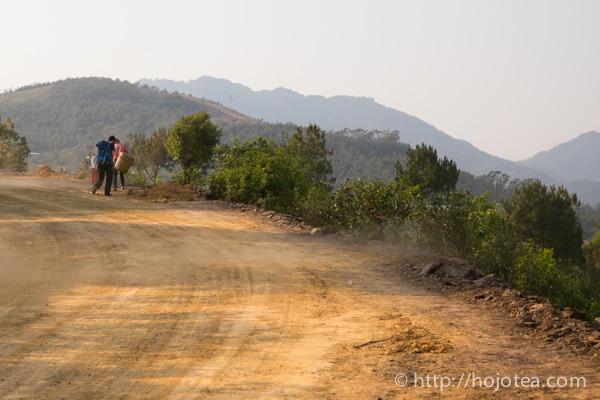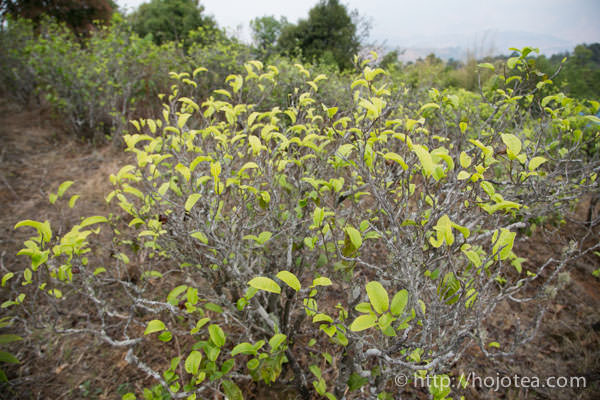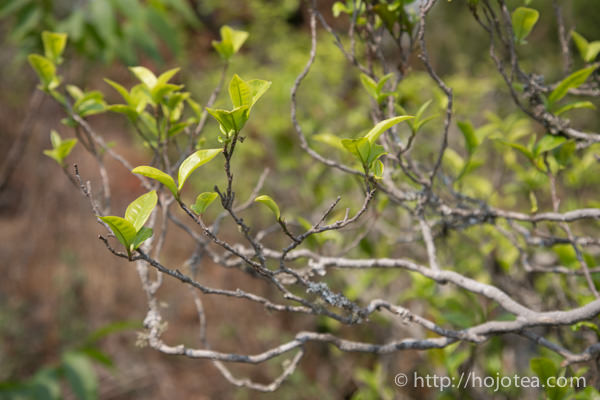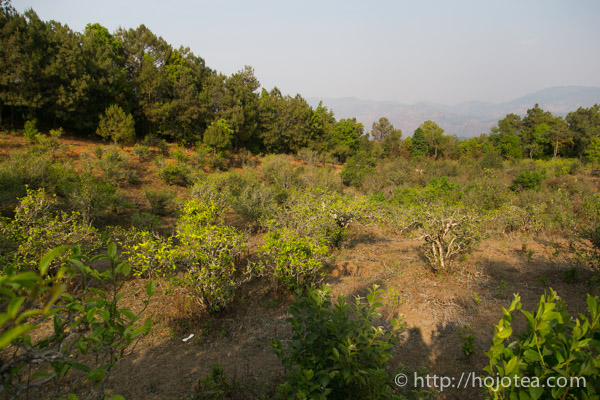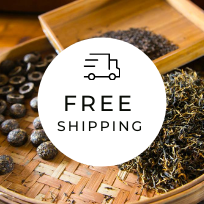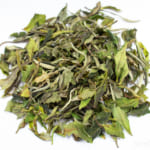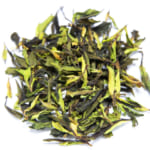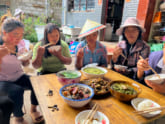- HOME >
- Types of Tea
Finding Mei Lan raw pu-erh tea at 2000m high
- [2014.06.05] Posted By Akira Hojo
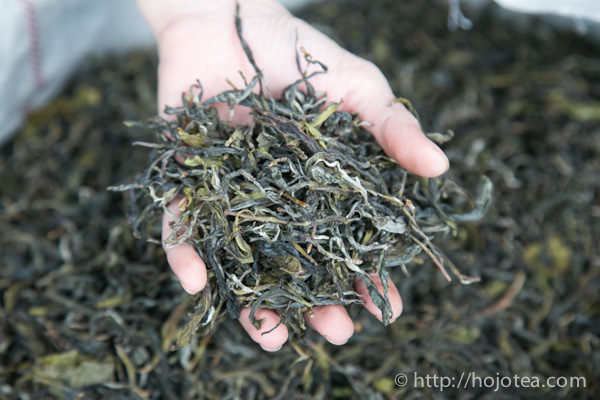
One of the most popular pu-erh tea in our existing line-ups is Mei Lan raw pu-erh tea. This tea gives a very distinctive flavour that reminds us of a pomelo, grapefruit skin and some other citrus fruit. Since the flavour is very unique and attractive, we were introducing Mei Lan in mao-cha form.
The village located nearby the Golden Triangle
We went to look for Mei Lan raw pu-erh tea again this year. This tea is produced in Lin Cang. The town is located near to the border of Myanmar. Looking from the map, it is situated right next to the so-called Golden Triangle where it is known as the major production area of drugs in Asia.
http://en.wikipedia.org/wiki/Golden_Triangle_(Southeast_Asia)
Therefore, there are many military checkpoints along the road heading to the town near the border. Their checking is actually much tighter than I have ever imagined. We often been asked to get down from the car and answer the questions given by the officers.
100% Natural Garden: No fertilizer, no pesticide and no pruning
The distinctive flavour of Mei Lan is developed thanks to the natural farming method. Natural farming means that tea was not pruned, and no fertilizer or pesticide is used. This tea trees are not planted in column by column as what we commonly see in a modern tea garden. Instead, the tea trees are grown one by one, like an independent bush. In modern tea garden, the number of tea trees per square feet is maximized and highly congested. The tea trees also often pruned so that the tea trees are kept at a manageable size for ground-level harvest. Besides, the frequent pruning also allows higher yield through a more compact arrangement of bushes. As a result, the sunshine does not reach the ground. If the number of tea trees is less congested, it allows the sunshine to reach the ground, and then naturally the number of weeds will increase. In the theory of natural farming, the existence of weeds is essential. Some weeds co-exist with a specific type of bacteria that usually lives on the roots of plants. The specific type of bacteria has an ability of intaking nitrogen from the air. The tea trees will not be depend on the fertilizers that applied by human as the source of nitrogen; the weeds will intake the necessary amount of nitrogen from the air and then supply for the surrounding ecology.
Very few number of leaves on the naturally farmed tea
As compared to modern garden tea, the tea grown with the natural farming method has very less number of tea leaves. In addition, the tea trees grow very slowly. Due to the slow growing speed, the tea leaf does not have to produce carbohydrate as it contains a very minimum number of chlorophylls. As a result, the tea leaf turns very yellowish, like the colour of ripen banana. Each tea leaf tends to contain a higher concentration of minerals, in particular the iron. Consequently, the naturally-grown tea gives extraordinarily strong aftertaste.
The flavour of Mei Lan is produced by the collaboration with the green fly
The farmer produces Mei Lan without using any pesticide or fertilizer. As I mentioned above, the tea garden is covered with weeds. These weeds provide homes for various kinds of insect. In particular, this environment is the utopia of the green flies from Homoptera group. This particular insect is of very small size, at about 1-2mm, and it loves to suck the juice from the young leaves. Once the tea leaf is being attacked, it turns more yellowish. When the leaf is attacked by the insect, it produces a substance called phytoalexin that may act like the human antibody. Interestingly, the tea leaf that is attacked by the insect will develop a very sweet flavour that is sometimes called muscatel or honey flavour. As the Mei Lan raw pu-erh tea is not highly fermented, it does not produce the flavour like honey or muscat. However, the distinctive flavour of Mei Lan is definitely related to the leaf attacked by the insect in some way, since I could smell the identical flavour on the fresh leaf.
The fresh leaf itself was so tasty
This year I particularly selected the tea that is harvested from the area at a higher altitude, at around 2000-2300m a.s.l. The tea was harvested during 20-25th of March. One thing that I was very impressed about the Mei Lan was that its leaves gave less bitter taste. When I chewed the fresh leaf, it almost has no astringency. It is a very rare experience for me. The leaf of Mei Lan was rather sweet and the sweetish sensation lingers for a long time in the throat. I was so impressed with its flavour, and when I was at the tea garden I kept eating many tea leaves. In overall, I am satisfied with the quality of Mei Lan that we bought this year.
Related Articles
How to get the latest update on HOJO Tea?
1. Follow Twitter, 2. Click "Like" on Facebook, and 3. Subscribe in newsletter. You can have the latest tea news from HOJO Tea.
 Subscribe the Newsletter to enjoy the privileges
Subscribe the Newsletter to enjoy the privileges- You may receive a free sample upon purchase, or you may have the priority to purchase special products. So please remember to subscribe our newsletter as well as the social network.
- Yunnan Chun Jian Green Tea from High Mountain Gardens
- Yunnan Chun Jian Green Tea is now available.This tea is made from naturally grown leaves harvested from high mountain gardens at 2100m above sea level. It has a rich, long-lasting lingering aftertaste, comparable to raw Pu-erh tea. Yunnan as a Distinctive Tea Growing Region Over the past 20 years, we have explored a wide range …
- Limited Loose Leaf Release of 2025 Da Xue Shan Wild Raw Pu-erh Tea
- We have released the 2025 loose-leaf version of Da Xue Shan Wild Raw Pu-erh Tea.This tea comes from wild tea trees that grow naturally in the high mountains of Yunnan Province, at elevations above 2000 meters. This year, we were only able to secure a small quantity for retail, and the current release is available …
NEW ARTICLES
 Yunnan Chun Jian Green Tea from High Mountain Gardens
Yunnan Chun Jian Green Tea from High Mountain Gardens- Yunnan Chun Jian Green Tea is now available.This tea is made from naturally grown leaves harvested from high mountain gardens at 2100m above sea level. It has a rich, long-lasting lingering aftertaste, comparable to raw Pu-erh tea. Yunnan as a Distinctive Tea Growing Region Over the past 20 years, we have explored a wide range …
 Limited Loose Leaf Release of 2025 Da Xue Shan Wild Raw Pu-erh Tea
Limited Loose Leaf Release of 2025 Da Xue Shan Wild Raw Pu-erh Tea- We have released the 2025 loose-leaf version of Da Xue Shan Wild Raw Pu-erh Tea.This tea comes from wild tea trees that grow naturally in the high mountains of Yunnan Province, at elevations above 2000 meters. This year, we were only able to secure a small quantity for retail, and the current release is available …
 2025 Da Xue Shan Wild White Tea Now Available from Yunnan
2025 Da Xue Shan Wild White Tea Now Available from Yunnan- The 2025 harvest of Da Xue Shan Wild White Tea is now available. Crafted from truly wild Camellia taliensis trees growing naturally in the high-altitude forests of Yunnan, this tea offers a purity and character unique to its origin. This year’s unusually dry climate during the withering season was ideal, resulting in a floral and …
 Why Do Some Teas Taste Astringent? Exploring the Causes and Mechanisms of Astringency
Why Do Some Teas Taste Astringent? Exploring the Causes and Mechanisms of Astringency- Tea can range from having no noticeable astringency to possessing a very strong one. What causes this astringency? This article explores the causes and mechanisms behind astringency in tea. Causes of Astringency Astringency arises from the binding of tea components to proteins in the oral cavity, creating a sensation of tightness or dryness. The tongue …
 The Impact of Heat Sources on Tea Flavor
The Impact of Heat Sources on Tea Flavor- It is widely recognized that the material of a kettle plays an important role in shaping the taste of water for brewing tea. Yet, an often overlooked but equally significant factor is the type of heat source used to boil the water. Different heat sources, whether gas, electric, charcoal, or wood fire, can impart distinct …
 New Release of High Mountain White Tea
New Release of High Mountain White Tea- We are pleased to introduce our High Mountain White Tea, sourced from a unique tea garden with two key features: 1. Located at an altitude of 2200-2300m2. Completely wild and untended The ideal natural conditions of this garden result in tea of exceptional quality, offering a pure and gentle, nourishing taste. High Altitude and Wild …
 New Release of Da Xue Shan Wild White Tea 2024
New Release of Da Xue Shan Wild White Tea 2024- We have released the 2024 Da Xue Shan Wild White Tea Loose Leaf. This tea was produced under our direct supervision during our stay in Yunnan Province, ensuring meticulous production management on site. Definition of Wild Tea in Yunnan Province People in Yunnan strongly associate Camellia taliensis with wild tea, regardless of where it is …
 New Release of Wild Pu-erh Jasmine Pearl
New Release of Wild Pu-erh Jasmine Pearl- Out of curiosity, we decided to create a jasmine tea based on Da Xue Shan Wild Raw Tea. This resulted in an exceptionally rare tea, not only in Japan but also in China. Custom Production Network for Jasmine Tea At our store, we source various types of base teas from different regions during the spring. …
 2024 Overview: Our Yunnan White Tea Quality, Process, and Weather Insights
2024 Overview: Our Yunnan White Tea Quality, Process, and Weather Insights- One of the teas we’ve been focusing on in Yunnan Province is white tea. Historically white tea has been produced in both Fujian Province and Yunnan Province for a long time. While white tea from Fujian Province is well-managed during processing, we are dissatisfied with the quality of the raw materials due to the use …
 Yunnan’s Hospitality Culture: Expressed Through Meals
Yunnan’s Hospitality Culture: Expressed Through Meals- In China, as a form of greeting, it’s common to say “你吃饭了吗?” which means “Have you eaten?” However, in Yunnan Province, the phrase “吃饭” is often used in various situations, more like “Eat, eat,” serving as an invitation to share a meal. Yet, with prolonged exposure to Yunnan, one comes to understand that these meal …
Shop Info

Address:Lot No. T-215, 3rd Floor, The Gardens Mall, Mid Valley City, Lingkaran Syed Putra, 59200 Kuala Lumpur
Tel: +603-2287-4537
Business Hour: 10am to 10pm
Category
- New Arrival at HOJO Online Shop
- Featured Articles
- Newsletter
- Types of Tea
- Origin of Tea
- Teapot and Tea Equipment
- Tea Column
- How to enjoy tea
- Tea Processing
- How to choose quality tea
- Tea constituents and functional effect
- Safety of Tea
- Foods
- Tea Business Operation
- Hobby and Outdoor Activity
- Ranking of Tea
- Video
- FAQ
- Media Release
Profile

- AKIRA HOJO
- I invite you to experience my tea selections.I was born in Nagano, Japan. In university, I studied agricultural chemistry, and I have the master degree in food science. I worked in Japanese food industry for 10 years. I involved in R&D, QC and QA. As a factory manager, I implemented ISO9000 series and managed the factory.
- The Art of Tea Magazine
- We posted the article on “The Art of Tea Magazine No.9, the magazine is published in Taiwan. We featured some scientific view about the tetsubin
- New Straits Times
- The Malaysian National Newspaper, New Straits Times featured HOJO Tea on 17-Oct-2007.

